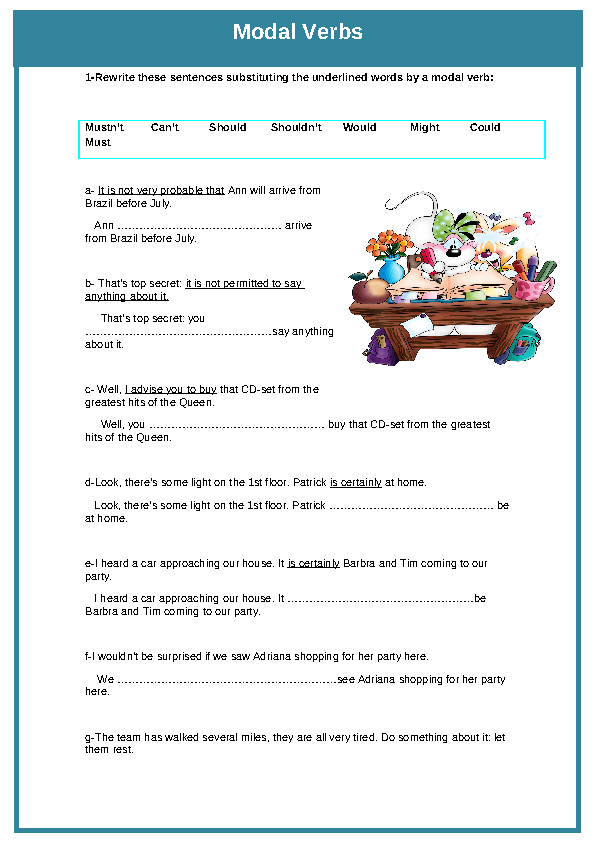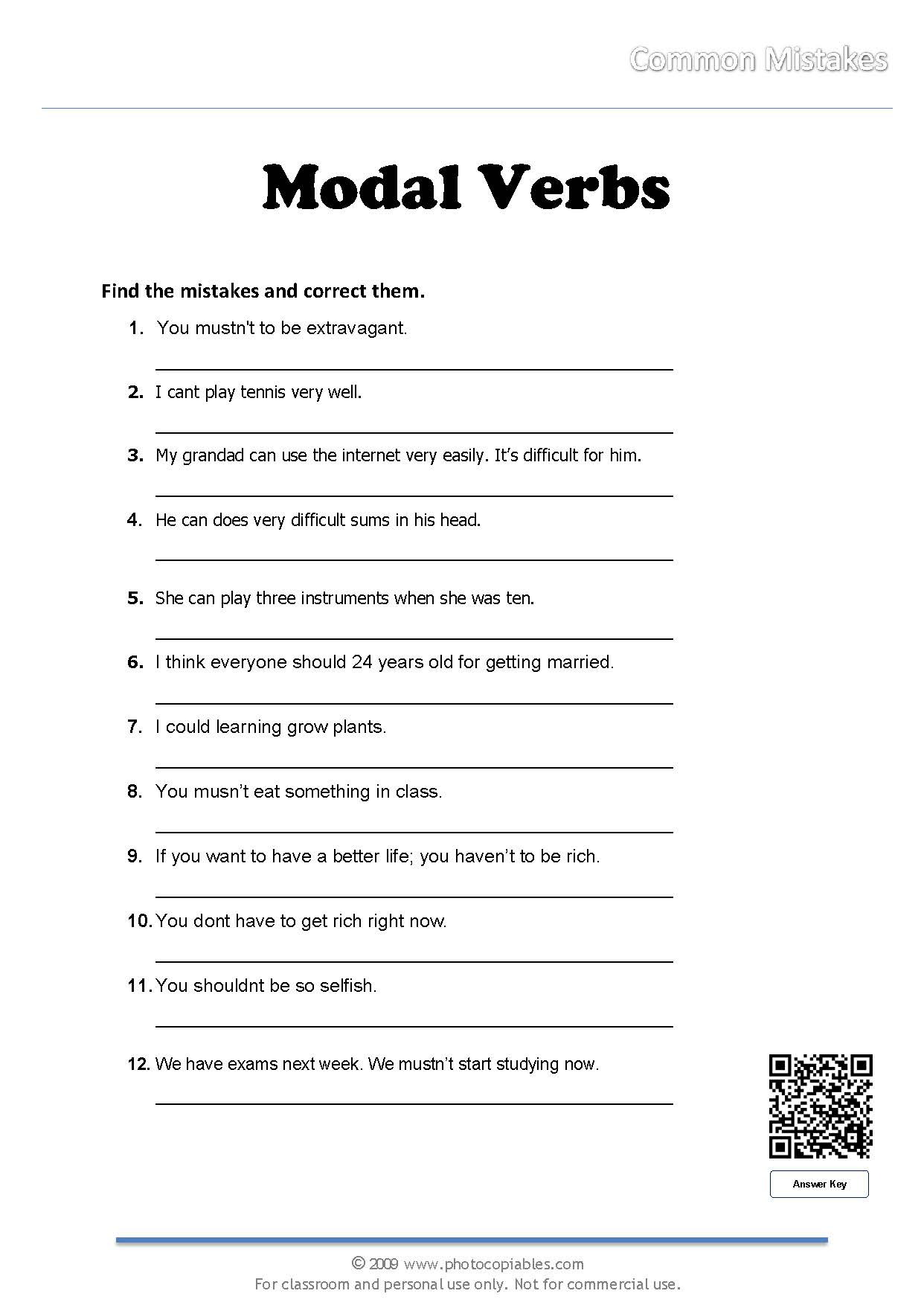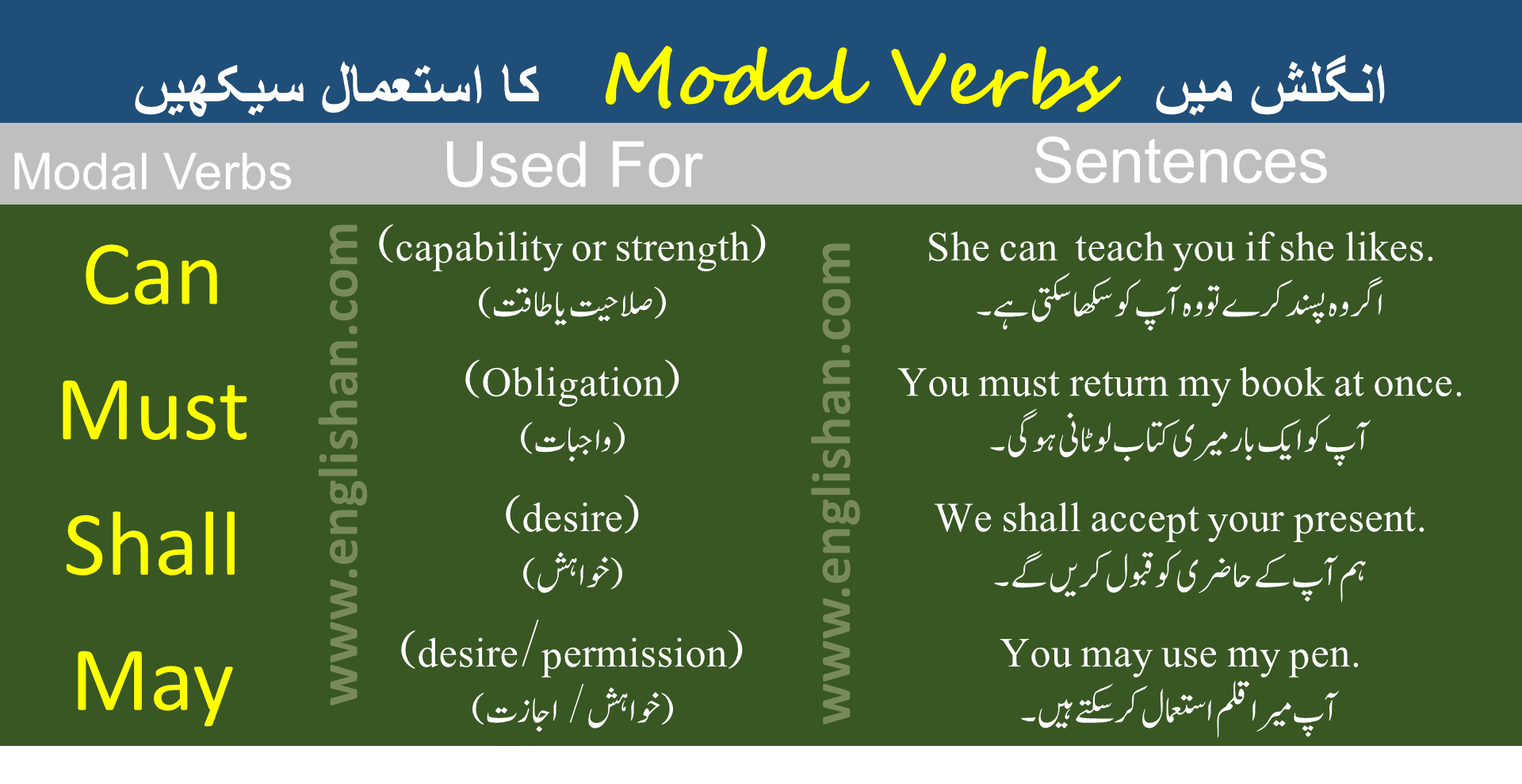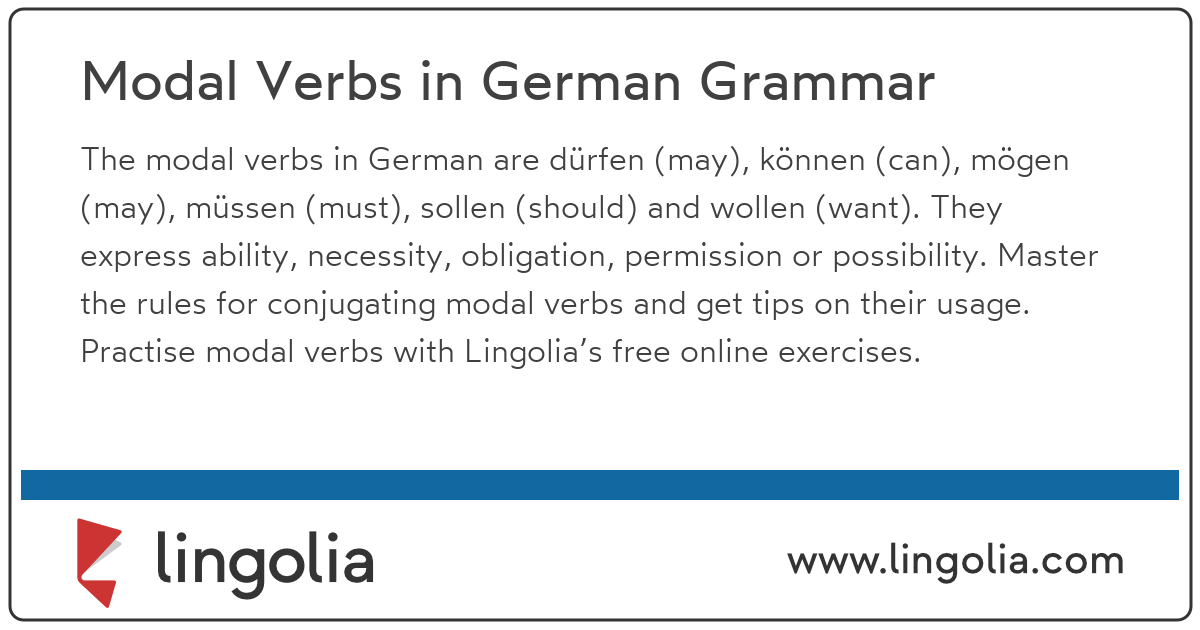Modal auxiliary verbs are used to show a necessity, capability, willingness, or possibility. Unlike most verbs, there is only one form of these verbs. Typically, verb forms change to indicate whether the sentence's structure is singular or plural. Most verbs also indicate whether something happened in the past, present, or future.
This is not the case with most modal auxiliary verbs, which makes them simpler to understand and use correctly. Like other auxiliary verbs, modal verbs work together with a main verb to give a different meaning to a sentence/clause than if the main verb was used by itself. Whethermodals,modal verbs,modal auxiliariesormodal auxiliary verbs, they are all the same. The modal verbs and the primary verbs are called auxiliary verbs.
The difference between these two groups of verbs is that we can use modal verbs as auxiliary verbs only. In other words, we cannot use modal verbs on their own in a sentence, as they are not complete by themselves. We have to use them with other verbs, which must be in the simple present tense. Modals/ modal verbs/ modal auxiliary verbs are a special type of verbs present in English grammar.
These verbs are used irregularly in English grammar. Uses of modal verbs in English grammar includes providing extra information about the action of the main verb. Remember that modal verbs are auxiliary verbs, or helping verbs, that are most commonly used to talk about possibility or necessity. You can also use modal verbs to ask for and give permission, describe ability, and give advice.
Modal verbs help qualify a verb by saying what a person can, may, should, or must do, as well as what might happen. The grammar used with modal verbs can be confusing at times. Generally speaking, modal verbs act like auxiliary verbs in that they are used together with a main verb.
Before we get started learning how to use modal verbs, let's take a look at what modal verbs are. According tothis article from Grammarly, modal verbs are classified as auxiliary verbs. "Auxiliary verbs" are helping verbs, which means you use them with other verbs in your sentences.
In English, main verbs but not modal verbs always require the auxiliary verb do to form negations and questions, and do can be used with main verbs to form emphatic affirmative statements. These auxiliaries express obligation, possibilities, permission or ability in a sentence by adding meaning to the main verb. As per modal verbs rules, the spelling or form do not change, unlike other verbs.
Modal verbs are auxiliary verbs, also known as helping verbs. They work with other verbs to show various conditions, such as possibility or necessity. Modal verbs do not change form based on the verb tense of the sentence; they do not have conjugated forms. Rather than being well-behaved classroom monitors helping the main verbs of a sentence, they are in fact linguistic rebels with an attitude problem. You may also find modal verbs referred to as "auxiliary verbs".
This is because they help the main verb by adding extra information about it to the sentence. The information it adds lets the listener know things like our intentions, the likelihood of an event, or if they are capable of or allowed to do something. There are a wide variety of modal auxiliary and their function. In this article, you will learn about the different uses of modal verbs in English grammar and as an added bonus, there are also modal verbs examples to help you understand the concept better. So, let's waste no more time and begin the learning journey.
Modal verbs are, essentially, auxiliary verbs, or helping verbs, as they're also called. However, perhaps the best way to think of modal verbs is as verbs that modify the meaning of the main verb. In English, modal verbsare a small class of auxiliary verbs used to express ability, permission, obligation, prohibition, probability, possibility, advice.
Note - The modal auxiliary verbs are always followed by the base form of the main verb. The nine modal verbs outlined above are different from other verbs in that they never change forms. Even when obeying subject-verb-agreement, these verbs will be identical when used with singular or plural subjects as in Cheetahs can run fast and a cheetah can run fast. In addition to this, these verbs typically are used only with certain verb tenses. For example, you are likely to hear the sentence It might be cloudy tomorrow but are unlikely to hear the sentence It might will be cloudy tomorrow. Generally speaking, these modal verbs are most often used with verbs in the present tenses .
Since modal auxiliary verbs do not have a past tense form, we can use the modal auxiliary along with the word 'have' and a past participle. Past participles typically end in -d, -ed, -n, or -en, creating the past tense 'wished, looked, taken,' and so forth. Let's take a look at an example in the present tense. Have to is often grouped with modal auxiliary verbs for convenience, but in fact it is not a modal verb. The verbs/expressions dare, ought to, had better, and need not behave like modal auxiliaries to a large extent, although they are not productive in the role to the same extent as those listed here.
In the strict sense, though, these other verbs do not qualify as modal verbs in English because they do not allow subject-auxiliary inversion, nor do they allow negation with not. If, however, one defines modal verb entirely in terms of meaning contribution, then these other verbs would also be modals and so the list here would have to be greatly expanded. A modal verb is an auxiliary verb that expresses necessity or possibility. An auxiliary verb, also called a helping verb, "helps" other verbs show moods and tenses. Auxiliary verbs include forms of do, be, and have.
In English, the modal verbs are used to express ability, possibility, permission or obligation. Each one of the modal verbs can be used to express one or more of these modalities. They can also be used to form the future tense in English and to make conditional sentences. Modal verbs grammar can become especially confusing when taking a look at the verbs which follow the modal verb itself. Usually, modal verbs' grammar dictates that modal verbs are followed by the base form of the verb to the present or future moment. However, Modal verbs can also be used with other forms of verbs.
The most common of these modal verbs' grammar forms is the use of the modal plus a perfect form to refer to a past time when using a modal verb of probability. Modal auxiliary verbs like can, may, ought, shall, and wood are used to suggest an impending or possible upcoming action. Learn to identify modal auxiliary verbs, understand their purpose, and indicate past tense with the provided examples. See the section on Conditional Verb Forms for help with the modal auxiliary would. The shades of meaning among modal auxiliaries are multifarious and complex.
Most English-as-a-Second-Language textbooks will contain at least one chapter on their usage. For more advanced students, A University Grammar of English, by Randolph Quirk and Sidney Greenbaum, contains an excellent, extensive analysis of modal auxiliaries. Modals can have multiple meanings, ambiguous readings and can even overlap with each other to mean the same thing in speech. Take the infamous grammar rule thatcan I is for asking about ability while may I is for asking permission. In common practice the two overlap and can mean the same thing.
This can certainly add to the general uncertainty and weakness that utterances with modal verbs are received than those without. Compare a sentence like "she's the murderer" to "she must be the murderer" or "she might be the murderer." The first is an ordinary declarative, that could be true or false but sounds objective. It makes it clearer that what seemed at first to be an objective statement is in fact from the point of view of the speaker.
In many Germanic languages, the modal verbs may be used in more functions than in English. In German, for instance, modals can occur as non-finite verbs, which means they can be subordinate to other verbs in verb catenae; they need not appear as the clause root. In Swedish, some modal verbs have infinitive forms. This for instance enables catenae containing several modal auxiliaries. The modal verbs are underlined in the following table.
And, as we've already said, modal verbs open up a whole new way of speaking and writing with their ability to quickly change the meaning of a verb and a sentence. Also, some questions can be considered impolite if not asked using a modal verb, so there's that to think about as well. All of these modal verbs must come before a verb to help express at least one of the modality examples listed above. In some cases, though they can be used to express more than one modality, but you'll see more on that in the following section. So, let's take a look at some example sentences and highlight how the modal verb is expressing modality and adding more information to the verbs that follow them.
All the auxiliary verbs except be, do and have are called modals. Unlike other auxiliary verbs modals only exist in their helping form; they cannot act alone as the main verb in a sentence. Prepared list of sentences using a wide range of modal auxiliary verbs . You may have heard auxiliary verbs referred to as helping verbs, but what is this type of verb, and what does it do in English? When we say it is "helping" a main verb, we mean it's helping to clarify it.
Explore what auxiliary verbs are and how they are used in English. The interpersonal aspect of how we use things like indirect speech acts, hedges, and modal verbs in some ways is more important than the literal lexical meaning itself. Crucially, modals and other hedges and indirect speech are commonly used by all of usto indicate a kind of cooperative politeness and reduce face threatening acts .
Scientists increasingly understand, perhaps in a way that the public doesn't yet, that using hedging language is often necessary to conscientiously convey more accurate degrees of certainty. This doesn't mean, however, that their findings should be dismissed as not authoritative. That allows for scholars to be more collegial and circumspect in presenting work, which may often challenge and pick apart the previous work of colleagues. Modal verbs are used to express ability, obligation, permission, assumptions, probability and possibility, requests and offers, and advice. Each modal verb can have more than one meaning which depends on the context of that sentence . It can be used to talk about ability and permission in the past.
Also, just like the modal verb "can", the modal verb "could" can be used to make questions, requests, suggestions or offers, but in a more polite way. It can also be used to talk about possibilities, but not as strong possibility that the one expressed with "can". Write down all the sentences with modal auxiliary verbs.
Indicate what type of modal auxiliary verb is used in each sentence. This activity will get students up and moving while they practice what they have learned about modal auxiliary verbs. As you've seen in this article, modal verbs are useful when it comes to expressing ideas and making polite requests. They're super versatile, and you can use them in all kinds of situations.However, make sure that you don't use too many modal verbs in your conversations. Similar to when you're making a request, modal verbs can change your sentence from a statement to a question.
That automatically makes your sentence sound more polite because it's not being presented as a demand. Notice that some of these modal verbs can be used in various situations. To avoid confusion, it's important that you understand the overall context of a sentence that includes a modal verb. That way, you won't be confused as to how the speaker is using the word. In academic writing, modal verbs are most frequently used to indicate logical possibility and least frequently used to indicate permission. Eight modal verbs are listed under each of the functions they can perform in academic writing, and are ordered from strongest to weakest for each function.
Notice that the same modal can have different strengths when it's used for different functions (e.g., may or can). Modal verbs are a part of the larger category called auxiliary verbs which are verbs that cannot be used on their own. Sometimes modal verbs are called modal auxiliaries. Hawaiian Pidgin is a creole language most of whose vocabulary, but not grammar, is drawn from English.
As is generally the case with creole languages, it is an isolating language and modality is typically indicated by the use of invariant pre-verbal auxiliaries. The invariance of the modal auxiliaries to person, number, and tense makes them analogous to modal auxiliaries in English. However, as in most creoles the main verbs are also invariant; the auxiliaries are distinguished by their use in combination with a main verb. Shall is a word that is used in England to express a future promise and to form a simple present for I and we. It's commonly used in formal and legal situations in the United States to form polite questions that include a polite request for permission. It can also be used to offer assistance, make suggestions, or ask for advice.
In definitions, it is referred to as a helping verb. There are certain modal verbs rules that encircle their use. It can be very beneficial if one can learn the rules and use of modal verbs as this will help you make grammatically correct English sentences. As a modal verb, "should" has many important uses in the English language.
It's used to give advice, to express what's right, and to recommend an action. Also, it's used to make predictions, but ones that are more uncertain than those with the other modal verbs. The main use of the modal verb "will" is to form the future form of the verbs in English.
Should Modal Verbs Be Used In A Sentence When talking about demands and requests, the use of will sometimes is not as polite as other modal verbs. When used with other verbs in the sentence, they can make your meaning as clear as you want it to be. Test your knowledge of modal verbs with an examination of may vs. might.

























